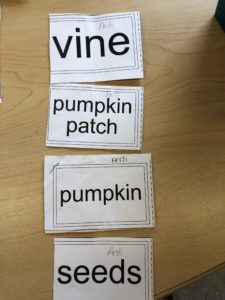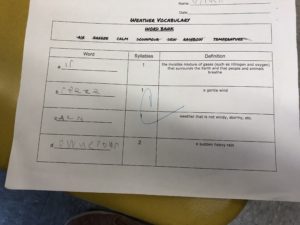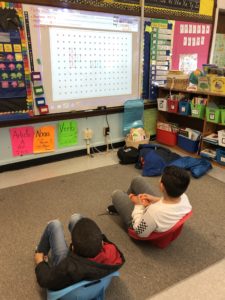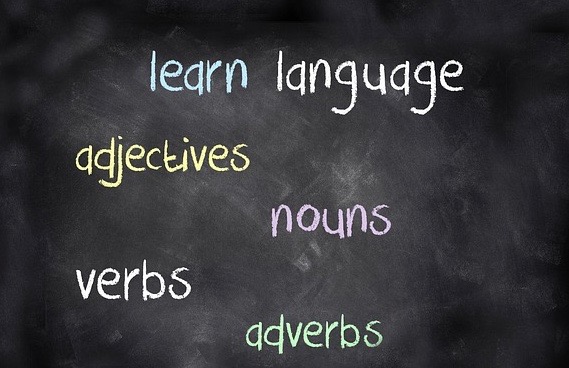This post is part of a series about helping students with LBLD experience academic success.
Read Lauren’s other blog posts:
Vocabulary instruction is a vital part of teaching
The more students understand vocabulary, the more they will be able to understand what they read, what they hear, and how they speak. I was reminded of the need for explicit vocabulary instruction during a study skills course that I took with Landmark Outreach. After taking the course, I have shifted my thinking and changed the way in which I approach teaching vocabulary in my classroom.
As a second grade teacher in self-contained language-based learning center in Quincy, Massachusetts, I am responsible for teaching in a way that my students will know, understand, and be able to use our new vocabulary words. The challenges are great. My students have a significant gap in word knowledge based on a variety of factors; they enter school with a much more limited vocabulary, limited background knowledge, and less exposure to books and reading outside of school. Some also have limited knowledge of the English language, limited exposure to rich vocabulary words, and a diagnosed disability or developmental delay. Vocabulary instruction needs to happen daily in my classroom.
In the past, I would take time to preview the text that we were going to read to pull out the most important words, words with which they might be unfamiliar and words that were important to understanding the main idea of the story. Sometimes these words would relate to each other and sometimes they would not. I would try to instruct both tier II and tier III words. We would work on those words for about a week and then move on to the next set of words, not every really mastering and using them in our everyday language
Use Thematic Units
Now, I teach my class vocabulary through the use of thematic units. The words are more relatable and the topics I choose at this level are based on real life and interesting topics. I choose text for us to read based my selection of words for the unit, and I know that my students will hear these words in a variety of contexts throughout the unit. I don’t get hung-up on the list of words I need to teach or the tiered level word we are learning because, honestly, most of my students have a lot of difficulty with even tier I vocabulary words. I find it important to start at the students’ level and give them multiple exposures with each word to help them be able to own it.
Use a Picture
This is a strategy I’ve learned directly from my Landmark Outreach coursework. I typically try and find a real life photograph related to my thematic unit and we brainstorm a list of words together from the photo. Then, I am able to help move my students from basic noun and verb word knowledge to more academic and higher level vocabulary words. For example, last week we were working on our Earth Day unit and I posted a picture of a team of workers cleaning up a beach. I asked my students, “what do you see in the picture?” and one boy said he saw a lot of trash. He was correct, but I was able to then teach the word litter as we were talking about the photograph. I asked, “What should they do with the used soda bottle?” and one girl said to put it in the “cycle can.” I then introduced the words reuse and recycle. By using this strategy, I am able to assess my students’ background knowledge, allow them to make connections, and build on what they already know. Throughout the week, I read stories to my students such as “Michael Recycle” by Ellie Bethel, “The Earth Book” by Todd Parr, “Curious George Plants a Tree” by Monica Perez , “Earth Day Celebration” by Alyssa Capucilli and “What If Everybody Did That?” by Colleen Madden and Ellen Javernick. As we discussed each book, I encouraged them to use our new vocabulary words, which are posted on our Earth Day Word Wall. The Word Wall displays their illustrations to go with the new words. It is amazing to hear the students engage in high level talk around the picture books. Using our new words multiple times in a way that relates to their lives enables them to store the vocabulary words in their long term memory.
Use a variety of vocabulary activities to enhance exposure and level of comfort with new vocabulary words
Not only is it important for us to explicitly teach vocabulary to our students, but they must have multiple exposures with these words to help them to learn and hold onto the newly learned information. Landmark has a variety of worksheets/activities that they have created to help students work with vocabulary words.
- Level of Knowledge Chart: This worksheet helps students assess their prior knowledge vocabulary words.
- Semantic Mapping: Semantic maps (or graphic organizers) are maps or webs of words. The purpose of creating a map is to visually display the meaning-based connections between a word or phrase and a set of related words or concepts. Semantic maps help students, especially struggling students and those with disabilities, to identify, understand, and recall the meaning of words they read in the text.
- Flashcards: Always an important reference, having student vocabulary words on one side of a card with the definition and part of speech on the other are a useful tool for learning new words.
- Word sorts: Have students sort their flashcards by tier, parts of speech, and/or specifics categories (such as number of syllables, alive/not alive, etc.)

- A-Z Vocabulary Sheet: See this example exercise for thematic vocabulary where students are given the first letter (or letter combination), how many syllables the word is, and the definition to help them identify words they will need to know for a unit.
- Vocabulary Illustrations: For students who demonstrate strength in visual learning, it can be a helpful activity to have them draw what they think a word looks like
- Two-column notes: This study skill can be useful for vocabulary, as well – have student put the words in the left column and the definitions in the right. You could also have them include illustrations with their definitions.
- Synonym-Antonym worksheet: This worksheet helps students to think more in depth about the meaning of a word by identifying its synonyms, as well as 2 levels of antonyms.
- Making Connections Worksheet: Here is another sheet that can help students to both make personal connections to words and illustrate them.
- Dictionary Skills: Teach students how to use a physical dictionary to practice alphabetical order order.
- Examples/Non-Examples:After defining a target word, come up with examples that fit that word, as well as examples that do not fit it.
- Quizlet.com: A great website for creating digital flashcards, as well as playing games and completing review activities to learn new words. With an account, it also tracks which words you know well, somewhat, and not at all.
- VocabularySpellingCity.com: This site is very useful for younger students who are learning new words, since it helps with spelling and vocabulary comprehension in a simple, easy-to-use format.
Directly teach students the importance of how to study their newly learned vocabulary words through the use of fun games
Lastly, I always thought of studying terms and definitions to be something that is done in the middle and high school level. After taking this course, I made the connection about how it is important for us to begin to teach our earliest learners how to work with newly learned information, quiz themselves, and use their own materials to help check their understanding of a word. Whether it is being able to fold over their two column notes worksheet, flip note cards, or play a review game, this skill needs to be taught at a young age to help them become successful learners.
- Flashcards: Use student flashcards to do a traditional review, looking at one side and trying to guess what is on the other. Students can also do this activity individually (or one-on-one with a teacher) and create three piles: I know it, I kind of know it, and I don’t know it.
- Two-column notes: This study guide can be folded along the margin and used for review by looking at either the word or definition side and trying to guess what is on the other side.
- Charades: Act out vocabulary words while students try to guess what word you mean.
- All Response: Give a definition and have students write the word they think mean on a personal white boards, or use popsicle sticks with words on them and have students hold up the stick they think has the correct word on it.

- Pictionary: Draw their words while the class guesses what you are trying to draw. This could also work in small groups.
- Dot Game: (Pictured to the right) Use a dot board and break class up into two teams. Give a definition and have students tell you the vocabulary word. If they get it correct they can draw a line between two dots. The goal is to be the team to close a box making it have four sides, then your team can get a point. Great for a fun interactive review game!



